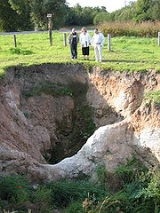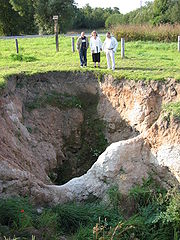
Biržai Regional Park
Encyclopedia
Biržai Regional Park covers 14,659 hectare
s in northern Lithuania
near its border with Latvia
. It was established in 1992 to preserve a distinctive karst
landscape. About 20% of its area is covered by forest.
 The park is notable for its sinkhole
The park is notable for its sinkhole
s, created by the dissolution of the gypsum
underlying its soil. About 9,000 sinkholes have been identified; the most notable is the Karves uola (Cow's Cave), which is about 20 meters deep. In 1998 the use of pesticides and fertilizers in the area was restricted.
Hectare
The hectare is a metric unit of area defined as 10,000 square metres , and primarily used in the measurement of land. In 1795, when the metric system was introduced, the are was defined as being 100 square metres and the hectare was thus 100 ares or 1/100 km2...
s in northern Lithuania
Lithuania
Lithuania , officially the Republic of Lithuania is a country in Northern Europe, the biggest of the three Baltic states. It is situated along the southeastern shore of the Baltic Sea, whereby to the west lie Sweden and Denmark...
near its border with Latvia
Latvia
Latvia , officially the Republic of Latvia , is a country in the Baltic region of Northern Europe. It is bordered to the north by Estonia , to the south by Lithuania , to the east by the Russian Federation , to the southeast by Belarus and shares maritime borders to the west with Sweden...
. It was established in 1992 to preserve a distinctive karst
KARST
Kilometer-square Area Radio Synthesis Telescope is a Chinese telescope project to which FAST is a forerunner. KARST is a set of large spherical reflectors on karst landforms, which are bowlshaped limestone sinkholes named after the Kras region in Slovenia and Northern Italy. It will consist of...
landscape. About 20% of its area is covered by forest.

Sinkhole
A sinkhole, also known as a sink, shake hole, swallow hole, swallet, doline or cenote, is a natural depression or hole in the Earth's surface caused by karst processes — the chemical dissolution of carbonate rocks or suffosion processes for example in sandstone...
s, created by the dissolution of the gypsum
Gypsum
Gypsum is a very soft sulfate mineral composed of calcium sulfate dihydrate, with the chemical formula CaSO4·2H2O. It is found in alabaster, a decorative stone used in Ancient Egypt. It is the second softest mineral on the Mohs Hardness Scale...
underlying its soil. About 9,000 sinkholes have been identified; the most notable is the Karves uola (Cow's Cave), which is about 20 meters deep. In 1998 the use of pesticides and fertilizers in the area was restricted.

